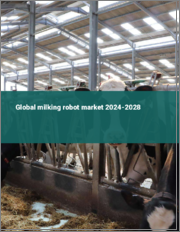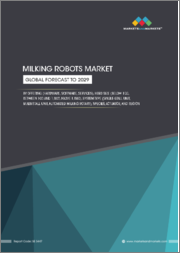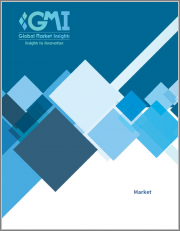
|
시장보고서
상품코드
1468527
착유 로봇 시장 보고서 : 제품, 유형, 목장 규모 및 지역별(2024-2032년)Milking Robots Market Report by Offering (Hardware, Software, Services), Type (Single-Stall Unit, Multi-Stall Unit, Rotary System), Herd Size (Up to 100, Between 100-1,000, Above 1,000), and Region 2024-2032 |
||||||
세계 착유 로봇 시장 규모는 2023년 20억 달러에 달했습니다. IMARC Group 2024-2032년 연평균 성장률(CAGR)이 9.3%로 2032년에는 45억 달러에 달할 것으로 예상하고 있습니다.
착유 로봇 또는 자동 착유 시스템(AMS)은 착유 절차를 완전히 자동화하여 작업자의 직접 참여를 줄이는 기계식 흡입 장치로, 착유 컵 쉘, 라이너, 펄세이터, 진공 펌프, 탱크, 레귤레이터, 게이지, 우유 품질을 평가하고 젖소에게 사료를 분배하는 데 도움이 되는 여러 센서가 포함되어 있습니다. 사료를 분배하는 데 도움이 되는 여러 센서가 포함됩니다. 착유 로봇은 기본 테스트, 증명 태그 식별, 젖소의 유량 및 전기 전도도 등 다양한 귀중한 데이터 및 입력 획득을 지원합니다. 이 외에도 착유 로봇은 인건비를 절감하고 숙련된 낙농 작업자에 대한 의존도를 낮추며, 우유 생산량을 늘리고 최소한의 시간으로 더 나은 착유 작업을 수행하여 수유 기간 동안 스트레스를 없앨 수 있습니다. 이러한 특성을 바탕으로 이 솔루션은 지속적인 테스트를 통해 감염 위험을 줄이고 우유 생산을 보장하기 위해 사용됩니다. 현재 착유 로봇은 주로 싱글 스톨, 멀티 스톨, 자동 착유 로터리 유형으로 나뉩니다.
착유 로봇 시장 동향 :
유제품 산업이 크게 성장하면서 인건비를 절감하고 우유 생산을 최적화하기 위해 기존 착유 기술보다 더 효과적인 AMS 솔루션에 대한 수요가 증가하고 있는 것이 시장 성장의 주요 원동력이 되고 있습니다. 또한, 우유, 응유, 버터 등 다양한 유제품의 건강상의 이점과 영양 성분이 풍부해지면서 수요가 증가하고 있는 것도 영향을 미치고 있습니다. 이와 함께, 로봇 프레임워크 모니터의 등장과 우유 흐름을 능동적으로 분석하여 유방염을 조기에 발견할 수 있는 자체 컨트롤러(SCC) 센서의 통합은 또 다른 성장 촉진요인으로 작용하고 있습니다. 이러한 기술은 착유 효율을 극대화하고, 세척의 필요성과 개별 분만실을 모니터링하는 데에도 도움이 되고 있습니다. 또한, 제품 품질 유지를 위해 목장 관리, 낙농장 관리 등 다양한 기능을 갖춘 여러 고도의 자동화 기술을 개발하는 업체들이 시장을 개척하고 있는 것도 시장 성장에 기여하고 있습니다. 이와는 별도로, 가축의 건강에 대한 관심이 높아지고 기술 지원이 잘 갖춰진 최첨단 로봇의 광범위한 도입이 시장 성장을 적극적으로 촉진하고 있습니다.
본 보고서에서 다룬 주요 질문들
- 2023년 착유 로봇 세계 시장 규모는?
- 2024-2032년 착유 로봇 세계 시장 성장률 전망은?
- 착유 로봇 세계 시장을 이끄는 주요 요인은?
- 코로나19가 착유 로봇 세계 시장에 미치는 영향은?
- 착유 로봇 세계 시장에서의 제품별 분류는?
- 유형별 착유 로봇 세계 시장 현황은?
- 착유 로봇 세계 시장 규모별 분류는?
- 착유 로봇 세계 시장 주요 지역은?
- 세계 착유 로봇 시장의 주요 진출 기업은?
목차
제1장 서문
제2장 조사 범위와 조사 방법
- 조사 목적
- 이해관계자
- 데이터 소스
- 1차 정보
- 2차 정보
- 시장 추정
- 보텀업 접근
- 톱다운 접근
- 조사 방법
제3장 주요 요약
제4장 서론
- 개요
- 주요 산업 동향
제5장 착유 로봇 세계 시장
- 시장 개요
- 시장 실적
- COVID-19의 영향
- 시장 예측
제6장 시장 분석 : 제품별
- 하드웨어
- 소프트웨어
- 서비스
제7장 시장 분석 : 유형별
- 싱글 스톨 유닛
- 멀티 스톨 유닛
- 로터리 시스템
제8장 시장 분석 : 우군 규모별
- 100마리 이하
- 100-1,000마리
- 1,000마리 이상
제9장 시장 분석 : 지역별
- 북미
- 미국
- 캐나다
- 아시아태평양
- 중국
- 일본
- 인도
- 한국
- 호주
- 인도네시아
- 기타
- 유럽
- 독일
- 프랑스
- 영국
- 이탈리아
- 스페인
- 러시아
- 기타
- 라틴아메리카
- 브라질
- 멕시코
- 기타
- 중동 및 아프리카
- 시장 동향
- 시장 분석 : 국가별
- 시장 예측
제10장 SWOT 분석
- 개요
- 강점
- 약점
- 기회
- 위협
제11장 밸류체인 분석
제12장 Porter의 Five Forces 분석
- 개요
- 바이어의 교섭력
- 공급 기업의 교섭력
- 경쟁 정도
- 신규 진출업체의 위협
- 대체품의 위협
제13장 가격 분석
제14장 경쟁 구도
- 시장 구조
- 주요 기업
- 주요 기업 개요
- Afimilk Ltd.
- BouMatic Robotics
- Dairymaster
- DeLaval(Tetra Laval)
- Fullwood Ltd.
- GEA Group AG
- Lely Industries N.V.
- Read Industrial Ltd.
- System Happel
- Waikato Milking Systems NZ LP
The global milking robots market size reached US$ 2.0 Billion in 2023. Looking forward, IMARC Group expects the market to reach US$ 4.5 Billion by 2032, exhibiting a growth rate (CAGR) of 9.3% during 2024-2032.
Milking robots, or automatic milking systems (AMS), represent mechanical suction machines that enable complete automation of milking procedures while mitigating the direct participation of operators. They include teat cup shells, liners, pulsators, vacuum pumps, tanks, regulators, gauges, and multiple sensors that help evaluate milk quality and dispense feed to cows. Milking robots aid in the underlying examination, distinguishing proof tags, and acquiring various valuable data and inputs, including cow milk production and electrical conductivity. Apart from this, milking robots save labor expenses, reduce dependency on skilled farm workers, increase milk yield, and eliminate stress throughout lactation by creating better milking routines in minimal duration. Based on these properties, the solution is used to reduce the risk of infections by conducting continuous tests and ensuring milk production. Currently, milking robots are mainly available in single-stall and multi-stall units and automated milking rotary types.
Milking Robots Market Trends:
The considerable expansion in the dairy industry and the increasing need for effective AMS solutions over conventional milking techniques to optimize milk production at reduced labor costs are primarily driving the market growth. This is further influenced by the rising demand for various dairy products, including milk, curd, and butter, owing to their multiple health benefits and nutritional compositions. In line with this, the advent of robot framework monitors and the integration of self-contained controller (SCC) sensors to proactively analyze milk flow and detect mastitis early are acting as another growth-inducing factor. Such technologies further help obtain maximum milkability and monitor cleaning requirements and individual quarters. Additionally, the ongoing development of multiple advanced automation technologies by manufacturers with diverse functions, including herd and farm management, to maintain product quality is impelling market growth. Apart from this, the rising herds' health concerns and the extensive uptake of state-of-the-art robots with enhanced technical support are positively augmenting the market growth.
Key Market Segmentation:
IMARC Group provides an analysis of the key trends in each sub-segment of the global milking robots market report, along with forecasts at the global, regional and country level from 2024-2032. Our report has categorized the market based on offering, type, and herd size.
Breakup by Offering:
Hardware
Software
Services
Breakup by Type:
Single-Stall Unit
Multi-Stall Unit
Rotary System
Breakup by Herd Size:
Up to 100
Between 100-1,000
Above 1,000
Breakup by Region:
North America
United States
Canada
Asia-Pacific
China
Japan
India
South Korea
Australia
Indonesia
Others
Europe
Germany
France
United Kingdom
Italy
Spain
Russia
Others
Latin America
Brazil
Mexico
Others
Middle East and Africa
Competitive Landscape:
The competitive landscape of the industry has also been examined along with the profiles of the key players being Afimilk Ltd., BouMatic Robotics, Dairymaster, DeLaval (Tetra Laval), Fullwood Ltd., GEA Group AG, Lely Industries N.V., Read Industrial Ltd., System Happel and Waikato Milking Systems NZ LP.
Key Questions Answered in This Report
- 1. What was the size of the global milking robots market in 2023?
- 2. What is the expected growth rate of the global milking robots market during 2024-2032?
- 3. What are the key factors driving the global milking robots market?
- 4. What has been the impact of COVID-19 on the global milking robots market?
- 5. What is the breakup of the global milking robots market based on the offering?
- 6. What is the breakup of the global milking robots market based on the type?
- 7. What is the breakup of the global milking robots market based on the herd size?
- 8. What are the key regions in the global milking robots market?
- 9. Who are the key players/companies in the global milking robots market?
Table of Contents
1 Preface
2 Scope and Methodology
- 2.1 Objectives of the Study
- 2.2 Stakeholders
- 2.3 Data Sources
- 2.3.1 Primary Sources
- 2.3.2 Secondary Sources
- 2.4 Market Estimation
- 2.4.1 Bottom-Up Approach
- 2.4.2 Top-Down Approach
- 2.5 Forecasting Methodology
3 Executive Summary
4 Introduction
- 4.1 Overview
- 4.2 Key Industry Trends
5 Global Milking Robots Market
- 5.1 Market Overview
- 5.2 Market Performance
- 5.3 Impact of COVID-19
- 5.4 Market Forecast
6 Market Breakup by Offering
- 6.1 Hardware
- 6.1.1 Market Trends
- 6.1.2 Market Forecast
- 6.2 Software
- 6.2.1 Market Trends
- 6.2.2 Market Forecast
- 6.3 Services
- 6.3.1 Market Trends
- 6.3.2 Market Forecast
7 Market Breakup by Type
- 7.1 Single-Stall Unit
- 7.1.1 Market Trends
- 7.1.2 Market Forecast
- 7.2 Multi-Stall Unit
- 7.2.1 Market Trends
- 7.2.2 Market Forecast
- 7.3 Rotary System
- 7.3.1 Market Trends
- 7.3.2 Market Forecast
8 Market Breakup by Herd Size
- 8.1 Up to 100
- 8.1.1 Market Trends
- 8.1.2 Market Forecast
- 8.2 Between 100-1,000
- 8.2.1 Market Trends
- 8.2.2 Market Forecast
- 8.3 Above 1,000
- 8.3.1 Market Trends
- 8.3.2 Market Forecast
9 Market Breakup by Region
- 9.1 North America
- 9.1.1 United States
- 9.1.1.1 Market Trends
- 9.1.1.2 Market Forecast
- 9.1.2 Canada
- 9.1.2.1 Market Trends
- 9.1.2.2 Market Forecast
- 9.1.1 United States
- 9.2 Asia-Pacific
- 9.2.1 China
- 9.2.1.1 Market Trends
- 9.2.1.2 Market Forecast
- 9.2.2 Japan
- 9.2.2.1 Market Trends
- 9.2.2.2 Market Forecast
- 9.2.3 India
- 9.2.3.1 Market Trends
- 9.2.3.2 Market Forecast
- 9.2.4 South Korea
- 9.2.4.1 Market Trends
- 9.2.4.2 Market Forecast
- 9.2.5 Australia
- 9.2.5.1 Market Trends
- 9.2.5.2 Market Forecast
- 9.2.6 Indonesia
- 9.2.6.1 Market Trends
- 9.2.6.2 Market Forecast
- 9.2.7 Others
- 9.2.7.1 Market Trends
- 9.2.7.2 Market Forecast
- 9.2.1 China
- 9.3 Europe
- 9.3.1 Germany
- 9.3.1.1 Market Trends
- 9.3.1.2 Market Forecast
- 9.3.2 France
- 9.3.2.1 Market Trends
- 9.3.2.2 Market Forecast
- 9.3.3 United Kingdom
- 9.3.3.1 Market Trends
- 9.3.3.2 Market Forecast
- 9.3.4 Italy
- 9.3.4.1 Market Trends
- 9.3.4.2 Market Forecast
- 9.3.5 Spain
- 9.3.5.1 Market Trends
- 9.3.5.2 Market Forecast
- 9.3.6 Russia
- 9.3.6.1 Market Trends
- 9.3.6.2 Market Forecast
- 9.3.7 Others
- 9.3.7.1 Market Trends
- 9.3.7.2 Market Forecast
- 9.3.1 Germany
- 9.4 Latin America
- 9.4.1 Brazil
- 9.4.1.1 Market Trends
- 9.4.1.2 Market Forecast
- 9.4.2 Mexico
- 9.4.2.1 Market Trends
- 9.4.2.2 Market Forecast
- 9.4.3 Others
- 9.4.3.1 Market Trends
- 9.4.3.2 Market Forecast
- 9.4.1 Brazil
- 9.5 Middle East and Africa
- 9.5.1 Market Trends
- 9.5.2 Market Breakup by Country
- 9.5.3 Market Forecast
10 SWOT Analysis
- 10.1 Overview
- 10.2 Strengths
- 10.3 Weaknesses
- 10.4 Opportunities
- 10.5 Threats
11 Value Chain Analysis
12 Porters Five Forces Analysis
- 12.1 Overview
- 12.2 Bargaining Power of Buyers
- 12.3 Bargaining Power of Suppliers
- 12.4 Degree of Competition
- 12.5 Threat of New Entrants
- 12.6 Threat of Substitutes
13 Price Analysis
14 Competitive Landscape
- 14.1 Market Structure
- 14.2 Key Players
- 14.3 Profiles of Key Players
- 14.3.1 Afimilk Ltd.
- 14.3.1.1 Company Overview
- 14.3.1.2 Product Portfolio
- 14.3.2 BouMatic Robotics
- 14.3.2.1 Company Overview
- 14.3.2.2 Product Portfolio
- 14.3.3 Dairymaster
- 14.3.3.1 Company Overview
- 14.3.3.2 Product Portfolio
- 14.3.4 DeLaval (Tetra Laval)
- 14.3.4.1 Company Overview
- 14.3.4.2 Product Portfolio
- 14.3.5 Fullwood Ltd.
- 14.3.5.1 Company Overview
- 14.3.5.2 Product Portfolio
- 14.3.6 GEA Group AG
- 14.3.6.1 Company Overview
- 14.3.6.2 Product Portfolio
- 14.3.6.3 Financials
- 14.3.6.4 SWOT Analysis
- 14.3.7 Lely Industries N.V.
- 14.3.7.1 Company Overview
- 14.3.7.2 Product Portfolio
- 14.3.8 Read Industrial Ltd.
- 14.3.8.1 Company Overview
- 14.3.8.2 Product Portfolio
- 14.3.9 System Happel
- 14.3.9.1 Company Overview
- 14.3.9.2 Product Portfolio
- 14.3.10 Waikato Milking Systems NZ LP
- 14.3.10.1 Company Overview
- 14.3.10.2 Product Portfolio
- 14.3.1 Afimilk Ltd.



















